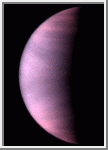|
COMETS EARTH JUPITER KUIPER BELT MARS MERCURY METEORITES NEPTUNE OORT CLOUD PLUTO SATURN SOLAR SYSTEM SPACE SUN URANUS VENUS ORDER PRINTS
PHOTO CATEGORIES SCIENCEVIEWS AMERICAN INDIAN AMPHIBIANS BIRDS BUGS FINE ART FOSSILS THE ISLANDS HISTORICAL PHOTOS MAMMALS OTHER PARKS PLANTS RELIGIOUS REPTILES SCIENCEVIEWS PRINTS
|
Related Document
Download Options
Venus Cloud Tops Viewed by HubbleThis is a NASA Hubble Space Telescope ultraviolet-light image of the planet Venus, taken on January 24 1995, when Venus was at a distance of 70.6 million miles (113.6 million kilometers) from Earth. Venus is covered with clouds made of sulfuric acid, rather than the water- vapor clouds found on Earth. These clouds permanently shroud Venus' volcanic surface, which has been radar mapped by spacecraft and from Earth-based telescope. At ultraviolet wavelengths cloud patterns become distinctive. In particular, a horizontal "Y"-shaped cloud feature is visible near the equator. Similar features were seen from Mariner 10, Pioneer Venus, and Galileo spacecrafts. This global feature might indicate atmospheric waves, analogous to high and low pressure cells on Earth. Bright clouds toward Venus' poles appear to follow latitude lines. The polar regions are bright, possibly showing a haze of small particles overlying the main clouds. The dark regions show the location of enhanced sulfur dioxide near the cloud tops. From previous missions, astronomers know that such features travel east to west along with the Venus' prevailing winds, to make a complete circuit around the planet in four days. Because Venus is closer to the Sun than Earth, the planet appears to go through phases, like the Moon. When Venus swings close to Earth the planet's disk appears to grow in size, but changes from a full disk to a crescent. The image was taken with the Wide Field Planetary Camera-2, in PC mode. False color has been used enhance cloud features. Credit: L. Esposito (University of Colorado, Boulder), and NASA
PHOTO CAPTION NO.: STScI-PRC95-16 |
